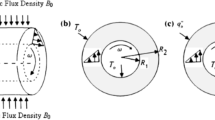Abstract
We consider the problem of steady convective flow during the directional solidification of a horizontal ternary alloy system rotating at a constant and low rate about a vertical axis. Under the limit of large far-field temperature, the flow region is modeled to be composed of two horizontal mushy layers, which are referred to here as a primary layer over a secondary layer. We first determine the basic state solution and then carry out linear stability analysis to calculate the neutral stability boundary and the critical conditions at the onset of motion. We find, in particular, that there are two flow solutions and each solution exhibits two neutral stability boundaries, and the flow can be multi-modal in the low rotating rate case with local minima on each neutral boundary. The critical Rayleigh number and the wave number as well as the vertical volume flux increase with the rotation rate, but the flow is found to be less stabilizing as compared to the binary alloy counterpart flow. The effects of low rotation rate increase the solid fraction and the liquid fraction at certain vertically oriented fluid lines, and the highest value of such increase is at a horizontal level close to the interface between the two mushy layers.












Similar content being viewed by others
References
Aitta, A., Huppert, H.E., Worster, M.G.: Diffusion-controlled solidification of a ternary melt from a cooled boundary. J. Fluid Mech. 432, 201–217 (2001a)
Aitta, A., Huppert, H.E., Worster, M.G.: Solidification in ternary systems. In: Ehrhard, P., Riley, D.S., Steen, P.H. (eds.) Interactive Dynamics of Convection and Solidification, pp. 113–122. Kluwer, Alphen aan den Rijn (2001b)
Amberg, G., Homsy, G.M.: Nonlinear analysis of buoyant convection in binary solidification with application to channel formation. J. Fluid Mech. 252, 79–98 (1993)
Anderson, D.M.: A model for diffusion-controlled solidification of ternary alloys in mushy layers. J. Fluid Mech. 483, 165–197 (2003)
Anderson, D.M., Worster, M.G.: Weakly nonlinear analysis of convection in mushy layers during the solidification of binary alloys. J. Fluid Mech. 302, 307–331 (1995)
Anderson, D.M., Schulze, T.P.: Linear and nonlinear convection in solidifying ternary alloys. J. Fluid Mech. 545, 213–243 (2005)
Anderson, D.M., Mcfadden, G.B., Coriell, S.R., Murray, B.T.: Convective instabilities during the solidification of an ideal ternary alloy in a mushy layer. J. Fluid Mech. 647, 309–333 (2010)
Bloomfield, L.J., Huppert, H.E.: Solidification and convection of a ternary solution cooled from the side. J. Fluid Mech. 489, 269–299 (2003)
Busse, F.H.: Nonlinear properties of thermal convection. Rep. Prog. Phys. 41, 1929–1967 (1978)
Chandrasekhar, S.: Hydrodynamic and Hydromagnetic Stability. Clarendon, Oxford (1961)
Chung, C.A., Chen, F.: Onset of plume convection in mushy layers. J. Fluid Mech. 408, 53–82 (2000)
Guba, P.: On the finite-amplitude steady convection in rotating mushy layers. J. Fluid Mech. 437, 337–365 (2001)
Riahi, D.N.: Nonlinear steady convection in rotating mushy layers. J. Fluid Mech. 485, 279–306 (2003)
Riahi, D.N.: On three-dimensional nonlinear buoyant convection in ternary solidification. Transp. Porous Media 103, 249–277 (2014)
Roper, S.M., Davis, S.H., Voorhees, P.W.: An analysis of convection in a mushy layer with a deformable permeable interface. J. Fluid Mech. 596, 335–352 (2008)
Sample, A.K., Hellawell, A.: The mechanisms of formation and prevention of channel segregation during alloy solidification. Metall. Trans. A 15, 2163–2173 (1984)
Skarda, J.R.L., McCaughan, F.E.: Exact solution to stationary onset of convection due to surface tension variation in multi-component fluid flow with interfacial deformation. Int. J. Heat Mass Transf. 42, 2387–2398 (1999)
Tait, S., Jahrling, K., Jaupart, C.: The planform of compositional convection and chimney formation in a mushy layer. Nature 359, 406–408 (1992)
Thompson, A.F., Huppert, H.E., Worster, M.G.: A global conservation model for diffusion-controlled solidification of a ternary alloy. J. Fluid Mech. 483, 191–197 (2003a)
Thompson, A.F., Huppert, H.E., Worster, M.G.: Solidification and compositional convection of a ternary alloy. J. Fluid Mech. 497, 167–199 (2003b)
Veronis, G.: Cellular convection with finite amplitude in a rotating fluid. J. Fluid Mech. 5, 401–435 (1959)
Worster, M.G.: Instabilities of the liquid and mushy regions during solidification of alloys. J. Fluid Mech. 237, 649–669 (1992)
Author information
Authors and Affiliations
Corresponding author
Appendix
Appendix
The coefficients \(b_{m} (m=1, {\ldots }, 8)\) introduced in (8) satisfy the following set of linear algebraic equations:
The coefficients \(b_{m}\,(m=9, {\ldots }, 16)\) introduced in (12) satisfy the following set of linear algebraic equations:
Rights and permissions
About this article
Cite this article
Riahi, D.N. Effect of Low Rotation Rate on Steady Convection During the Solidification of a Ternary Alloy. Transp Porous Med 116, 705–726 (2017). https://doi.org/10.1007/s11242-016-0797-5
Received:
Accepted:
Published:
Issue Date:
DOI: https://doi.org/10.1007/s11242-016-0797-5




